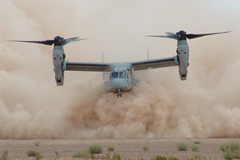
| AFRL Develops Partial
Solution to Helicopter Brownout |
|
|
5/9/2007 - EGLIN AIR FORCE BASE, FL -- The Air Force Research Laboratory Rapid Reaction Team has successfully integrated and tested a science and technology solution to the Air Force Special Operation Command helicopter brownout problem. In late 2005, Lt. Gen. Michael Wooley, AFSOC commander, asked the AFRL commander to find a solution to a problem that is killing his Airmen -- rotary wing brownouts. More than 30 AFSOC rotary wing aircraft and 60 servicemembers have lost their lives due to reduced visibility conditions during landing in desert environments. Many of the aircraft losses have been attributed to a condition that helicopter pilots refer to as "brownout." "Brownout conditions occur during landing and take-offs from sand or dirt. The sand and dirt is blown up off the ground and blinds the helicopter pilots to the surrounding area, much like being in a whiteout during a blizzard," said Eric Werkowitz, the effort's program manager who is from the Munitions Directorate here. In less than five months from his request, the team had begun flying a system on a commercial helicopter. Scientists and engineers at AFRL worked with Applied Minds, Inc. to develop a short-term prototype "see and remember" system which will reduce aircraft accidents resulting from the loss of visual cues during take-off and landings in dusty conditions. This science and technology solution, known as Photographic Landing Augmentation System for Helicopters, or "PhLASH" for short, is a combination of an electro-optical sensor and infrared strobe lights which images and geo-registers (matches the image to a coordinate on the earth's surface) the ground prior to landing in brownout conditions. "During the final approach, but before entering brownout, the system captures a series of high resolution digital still images of a landing area, and transforms the images in real-time based on the subsequent flight path of the helicopter," Werkowitz said. "The result is a video-like display of the landing area and nearby obstacles, along with symbology indicating the current position of the helicopter. The display will not reflect changes to the landing zone after the most recent photo (before brownout is encountered) until landing, but in most cases this time span will be less than 20 seconds." "We call the concept 'See and Remember'" he said. AFRL recently completed development testing and operational testing of the system on a MH-53 helicopter. The next phase of PhLASH program is integration on operational helicopters. The Office of the Secretary of Defense selected the PhLASH system for $1.75 milllion of Quick Reaction Funding to develop a ruggedized system suitable for permanent installation. Source: USAF/Eglin AFB Press Release by Rex Swenson |
| |
